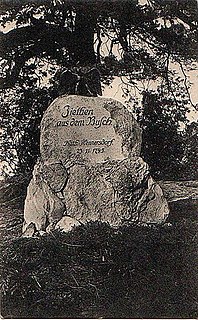Related Research Articles

Friedrich Wilhelm Freiherr von Seydlitz was a Prussian officer, lieutenant general, and among the greatest of the Prussian cavalry generals. He commanded one of the first Hussar squadrons of Frederick the Great's army and is credited with the development of the Prussian cavalry to its efficient level of performance in the Seven Years' War. His cavalryman father retired and then died while Seydlitz was still young. Subsequently, he was mentored by Margrave Frederick William of Brandenburg-Schwedt. Seydlitz's superb horsemanship and his recklessness combined to make him a stand-out subaltern, and he emerged as a redoubtable Rittmeister in the War of Austrian Succession (1740–1748) during the First and Second Silesian Wars.

Cuirassiers were cavalry equipped with a cuirass, sword, and pistols. Cuirassiers first appeared in mid-to-late 16th century Europe as a result of armoured cavalry, such as men-at-arms and demi-lancers, discarding their lances and adopting the use of pistols as their primary weapon. In the later part of the 17th century the cuirassier lost his limb armour and subsequently wore only the cuirass, and sometimes a helmet. By this time, the sword or sabre had become his primary weapon, with pistols relegated to a secondary function.
The Cuirassier Regiment "Queen" (Pomeranian) No. 2 was a Prussian cavalry regiment. Formed in 1717 as Dragoner-Regiment Nr.5 Bayreuth Dragoner it was originally a dragoon regiment and was part of the Prussian order of battle until 1918. The Bayreuth Dragoons achieved fame for their role in winning the Battle of Hohenfriedberg in 1745. In 1819 it was transformed into a cuirassier regiment.

The Battle of Soor was a battle between Frederick the Great's Prussian army and an Austro-Saxon army led by Prince Charles Alexander of Lorraine during the Second Silesian War. The battle occurred in the vicinity of Soor, also known as Hajnice, in the modern day Czech Republic. The battle started with a failed Austrian surprise attack on the outnumbered Prussians. Despite initial setbacks the Prussian army managed to defeat the Austrians, due to an unexpected attack from a reserve regiment that refused to follow Frederick's orders.

The Guards Cavalry Division (Garde-Kavallerie-Division) was a unit of the Prussian Army that was stationed in Berlin. The division was a part of the Guards Corps (Gardekorps).
This is an order of battle of the French and German Armies at the beginning of the Franco-Prussian War in 1870.

The Battle of Hennersdorf, sometimes referred to as Catholic-Hennersdorf, was a minor encounter that took place on November 23, 1745 in Katholisch-Hennersdorf in Silesia during the Second Silesian War. The Prussians under Frederick II defeated the Austrians under Prince Charles Alexander of Lorraine. The Prussians surprised the Austrians and Saxons in their cantonments in Lusatia with the most success at Hennersdorf. There a force of two regiments of hussars and two regiments of cuirassiers under Zieten attacked a small force of two battalions of Saxon infantry and three regiments of Saxon cavalry. The Saxons, after making a desperate stand, were overwhelmed by the arrival of additional Prussian cavalry, infantry and artillery.

The Imperial Guard of Napoleon III was a military corps in the French Army formed by Napoleon III as a re-establishment of his uncle Napoleon I's Imperial Guard, with an updated version of the original uniforms and almost the same privileges.
The Bavarian Army was the army of the Electorate (1682–1806) and then Kingdom (1806–1919) of Bavaria. It existed from 1682 as the standing army of Bavaria until the merger of the military sovereignty (Wehrhoheit) of Bavaria into that of the German State in 1919. The Bavarian Army was never comparable to the armies of the Great Powers of the 19th century, but it did provide the Wittelsbach dynasty with sufficient scope of action, in the context of effective alliance politics, to transform Bavaria from a territorially-disjointed small state to the second-largest state of the German Empire after Prussia.

The Guards Cuirassiers were a heavy cavalry regiment of the Royal Prussian Army. Formed in 1815 as an Uhlans regiment, it was reorganized as a cuirassiers unit in 1821. The regiment was part of the Guards Cavalry Division and fought in the Second Schleswig War, the Austro-Prussian War, the Franco-Prussian War and World War I. The regiment was disbanded in September 1919.
The 3rd Cuirassiers “Count Wrangel” were a heavy cavalry regiment of the Royal Prussian Army. Formed in 1717 as a dragoons unit, the regiment was reorganized as cuirassiers in 1818. The regiment fought in the Silesian Wars, the War of the Sixth Coalition, the Austro-Prussian War, the Franco-Prussian War and World War I.
The 4th (Westphalian) Cuirassiers “von Driesen” was a heavy cavalry regiment of the Royal Prussian Army. The regiment was formed in 1717. The regiment fought in the Silesian Wars, the War of the Sixth Coalition, the Austro-Prussian War, the Franco-Prussian War and World War I. The regiment was disbanded in 1919.
The 5th Cuirassiers “Duke Frederick Eugene of Württemberg” were a heavy cavalry regiment of the Royal Prussian Army. The regiment was formed in 1717. The regiment fought in the Silesian Wars, the War of the Sixth Coalition, the Austro-Prussian War, the Franco-Prussian War and World War I. It was disbanded in 1919.
The 6th (Brandenburg) Cuirassiers “Emperor Nicholas I of Russia” were a heavy cavalry regiment of the Royal Prussian Army. The regiment was formed in 1807. The regiment fought in the War of the Sixth Coalition, the Second Schleswig War, the Austro-Prussian War, the Franco-Prussian War and World War I. The regiment was disbanded in 1919.
The 7th (Magdeburg) Cuirassiers “von Seydlitz” were a heavy cavalry regiment of the Royal Prussian Army. The regiment was formed in 1815. The regiment fought in the War of the Sixth Coalition, the Austro-Prussian War, the Franco-Prussian War and World War I. The regiment was disbanded in 1919.
The 8th (Rhenish) Cuirassiers “Count Geßler” were a heavy cavalry regiment of the Royal Prussian Army. The regiment was formed in 1815. The regiment fought in the Austro-Prussian War, the Franco-Prussian War and World War I. The regiment was disbanded in 1919.
The 1st Royal Saxon Guards Heavy Cavalry was a heavy cavalry of the Royal Saxon Army. Established in 1680 as a cuirassiers unit, the regiment fought in the Battle of Vienna (1683), the Nine Years' War, the War of the Spanish Succession, the Silesian Wars, the Napoleonic Wars, the Austro-Prussian War, the Franco-Prussian War and World War I. The regiment was disbanded in 1919.
The 2nd Royal Bavarian Heavy Cavalry "Archduke Francis Ferdinand of Austria" were a heavy cavalry regiment of the Royal Bavarian Army. The normal peacetime location of the regiment was Landshut. The regiment was formed in 1815 as a cuirassiers unit and fought in the Austro-Prussian War, the Franco-Prussian War and World War I. The regiment was disbanded in 1919.
Ernst Christoph von Nassau, sometimes called Christoph Ernst, was a Prussian general lieutenant and knight of the Black Eagle Order. He is memorialized on the Equestrian statue of Frederick the Great. After fighting in the Prussian army during the War of Spanish Succession, he transferred to the Hessian army; subsequently, he served during peacetime in the army of the Duke of Saxony and in 1740, upon the ascension of Frederick in 1740, he rejoined the Prussian army and served in the War of Austrian Succession.
The Battle of Neustadt on 25 March 1760 saw Heinrich von Manteuffel's Prussian Army defeat the Austrian army under Ernst von Laudon during the Third Silesian War.
References
Schulz, Hugo (1992). Die preussischen Kavallerie-Regimenter 1913/1914 nach dem Gesetz vom 3. Juli 1913. Augsburg: Weltbild. pp. 14–16. ISBN 3893503439.